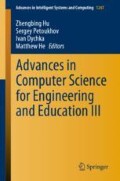Abstract
E-Government is a set of pervasive technologies and automated processes now. The open data plays a crucial role in the successful implementation of this concept. The Open Data Platform (ODP) architecture is described here as the framework for the open data access systems implementation, including specific requirements. The proposed architecture and its components were discussed in this paper in detail for its availability, productivity, and reliability. The open data subsystem based on the architecture presented here was developed for the Jordan Government and was successfully implemented and tested. Thus, this architecture showed its viability.
The focus of the paper is the detailed analysis of the proposed ODP architecture and its characteristics. The ODP is a significant system for the mature e-Government. We propose here the architecture for it with usage-proven characteristics. This fact adds the value to the e-Government framework stability, and significant characteristics and improves the overall quality of the system.
Access this chapter
Tax calculation will be finalised at checkout
Purchases are for personal use only
References
Alhawawsha, M.: A comparison of the E-government system architecture in Jordan with the E-government system of the United States. Sci. J. 34(2/2), 18–24 (2017). https://doi.org/10.15587/2312-8372.2017.100190. Technology Audit and Production Reserves
Alhawawsha, M.: Developing of the e-government system based on java for online voting. Sci. J. 3(35), 9–13 (2017). https://doi.org/10.15587/2312-8372.2017.104033. Technology Audit and Production Reserves
Alhawawsha, M., Glybovets, A.: E-government versus SMART government: Jordan versus the United States. Eureka J. 31(3), 3–11 (2017). https://doi.org/10.21303/2504-5571.2017.00338
Alhawawsha, M., Glybovets, A.: E-government developed system prototype about USA and Jordan. Geom. Model. Inf. Technol. N1(3), 26–42 (2017)
Alhawawsha, M.: Identification of the issues in the E-governance in Jordan and USA. Inf. Syst. Technol. 6(1/1), 37–40 (2017)
Saleh, Z.I., Obeidat, R.A., Khamayseh, Y.: A framework for an E-government based on service-oriented architecture for Jordan. Int. J. Inf. Eng. Electron. Bus. (IJIEEB), 5(3), 1–10 (2013). MECS Press. https://doi.org/10.5815/ijieeb.2013.03.01
Osho, L.O., Abdullahi, M.B., Osho, O., Alhassan, J.K.: Effective networking model for efficient implementation of e-governance: a case study of Nigeria. Int. J. Inf. Eng. Electron. Bus. (IJIEEB), 7(1), 18–28 (2015). MECS Press. https://doi.org/10.5815/ijieeb.2015.01.03
Balakumaran, P.J, Ramamoorthy, H.V.: Evolving an E-governance system for local self-government institutions for transparency and accountability. Int. J. Inf. Eng. Electron. Bus. (IJIEEB), 5(6), 40–46 (2013). MECS Press. https://doi.org/10.5815/ijieeb.2013.06.05
Olaniyan, J.O., Ademuyiwa, A.J.: Comparative analysis of personnel distributions in the local government service in ekiti-state, Nigeria, for service delivery. Int. J. Math. Sci. Comput. (IJMSC), 5(2), 44–53 (2019). MECS Press. https://doi.org/10.5815/ijmsc.2019.02.04
Mohammad, H., Almarabeh, T., Ali, A.A.: E-government in Jordan. Eur. J. Sci. Res. 35(2), 188–197 (2009)
Majdalawi, Y.K., lmarabeh, T., Mohammad, H., Quteshate, W.: E-government strategy and plans in Jordan. J. Softw. Eng. Appl. 8, 211–223 (2015). https://doi.org/10.4236/jsea.2015.84022
AlSukhayri, A.M., Aslam, M.A., Arafat, S., Aljohani, N.R.: Leveraging the Saudi linked open government data: a framework and potential benefits. Int. J. Modern Educ. Comput. Sci. (IJMECS), 11(7), 14–22, (2019). MECS Press. https://doi.org/10.5815/ijmecs.2019.07.02
Panchenko, T.: Compositional methods for software systems specification and verification, Ph.D. Thesis, Kyiv (2006). 177 p
Panchenko, T.: Application of the method for concurrent programs properties proof to real-world industrial software systems. In: Proceedings of ICTERI, pp. 119–128 (2016)
Ostapovska, Y.A., Panchenko, T.V., Polishchuk, N.V., Kartavov, M.O.: Correctness property proof for the banking system for money transfer payments, Probl. Program. 6(2–3), 119–132 (2018)
Panchenko, T., Ivanov, I.: A formal proof of properties of a presentation system using Isabelle. In: Proceedings 2017 IEEE First Ukraine Conference on Electrical and Computer Engineering, UkrCon, pp. 1155–1160. IEEE (2017)
Panchenko, T., Fabunmi, S.: Quality of concurrent shared memory programs. In: Proceedings 2018 11th International Conference on the Quality of Information and Communications Technology, QUATIC, pp. 299–300. IEEE (2018)
Ivanov, I., Panchenko, T., Nikitchenko, M., Sunmade. F.: On formalization of semantics of real-time and cyber-physical systems. In: Proceedings International Conference on Computer Science, Engineering and Education Applications, pp. 213–223. Springer, Cham (2018)
Panchenko, T., Shyshatska, O., Omelchuk, L., Rusina, N., Fabunmi, S.: Compositional-nominative approach to the client-server systems properties proofs within different formal execution models. In: Proceedings of 2019 IEEE 2nd Ukraine Conference on Electrical and Computer Engineering, UKRCON, pp. 1127–1132 (2019). https://doi.org/10.1109/ukrcon.2019.8880029
Author information
Authors and Affiliations
Corresponding author
Editor information
Editors and Affiliations
Rights and permissions
Copyright information
© 2021 The Editor(s) (if applicable) and The Author(s), under exclusive license to Springer Nature Switzerland AG
About this paper
Cite this paper
Alhawawsha, M., Panchenko, T. (2021). Open Data Platform Architecture and Its Advantages for an Open E-Government. In: Hu, Z., Petoukhov, S., Dychka, I., He, M. (eds) Advances in Computer Science for Engineering and Education III. ICCSEEA 2020. Advances in Intelligent Systems and Computing, vol 1247. Springer, Cham. https://doi.org/10.1007/978-3-030-55506-1_56
Download citation
DOI: https://doi.org/10.1007/978-3-030-55506-1_56
Published:
Publisher Name: Springer, Cham
Print ISBN: 978-3-030-55505-4
Online ISBN: 978-3-030-55506-1
eBook Packages: Intelligent Technologies and RoboticsIntelligent Technologies and Robotics (R0)

